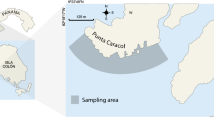Summary
-
1.
Observation of coral reef fish in Jamaica revealed a continuous and erratic series of fluctuations in both individual and species group size.
-
2.
No apparent trend existed between group size or species composition with any subsequent changes in the group. However, solitary striped parrots did, eventually, join conspecifics and very large groups fragmented. Other species (i.e., redtail parrot, ocean surgeon, blue tang, spotted goatfish, and foureye buttefly fish) did join the striped parrot groups for brief periods and tended to be solitary for long periods of time.
-
3.
The rapid compositional changes were attributed to the different foraging strategies of the component species. Two basic strategies were identified; the striped parrot and the stoplight parrot strategies. Both herbivores and carnivores occurred in each strategy.
-
4.
Species utilizing the striped parrot strategy (e.g., striped parrot, blue tang, ocean surgeon, and spotted goatfish) fed in open areas of sand, grass, and/or small rubble. The feeding behavior consisted of rapid, consecutive nips at the substrate with little time invested searching for food once the animal settled to the substrate.
-
5.
Species utilizing the stoplight parrot strategy (e.g., stoplight parrot, redtail parrot, and the foureye butterfly fish) appeared to carefully search the crevices or the surfaces before making a nip. Multiple nips usually contained search time between each nip.
-
6.
The species utilizing the striped parrot strategy formed and disbanded in the open areas and appeared to forage on a homogenuous resource. An individual joined others already engaged in foraging and fed only within its immediate area of settlement. Once food was exhausted, it left the group and joined another or began foraging on its own.
-
7.
The species using the stoplight parrot strategy moved from one patchy resource to another and joined groups mainly as they passed through the open areas.
-
8.
The mixed-species groups were products of seemingly random encounters between species having different foraging strategies.
Similar content being viewed by others
References
Altman, S.A.: Baboons, space, time, and energy. Amer. Zool. 14, 221–248 (1974)
Barlow, G.W.: Extraspecific imposition of social grouping among surgeon fishes. (Acanthuridae, Pisces) J. Zool. Lond. 174, 333–340 (1974)
Caraco, T., Wolf, L.L.: Ecological determinations of group sizes of foraging lions. Amer. Nat. 109, 343–352 (1975)
Horn, H.S.: The adaptive significance of colonial nesting in the Brewer's blackbird (Euphagus cyanocephalus). Ecol. 49, 682–694 (1968)
Itzkowitz, M.: A behavioural reconnaissance of some Jamaican reef fishes. Zool. Linn. Soc. 55, 87–118 (1974)
Jarman, P.J.: The social organization of antelope in relation to their ecology. Behav. 47, 215–267 (1974)
Krebs, J.R., Ryan, J.C., Charnov, E.L.: Hunting by expectation or optimal foraging? A study of patch use by chickadees. Anim. Behav. 22, 953–964 (1974)
Kummer, H.: Social organization of Hamadryas baboons, p. 189. Chicago: Univ. of Chicago Press 1968
Moroney, M.J.: Facts from figures. Harmondsworth, Middlesex: Penguin 1951
Morse, D.H.: Niche Breadth as a function of social dominance. Amer. Nat. 108, 818–830 (1974) 40, 119-168 (1970)
Morse, D.H.: Niche Breadth as a function of social dominance. Am. Nat. 108, 818–830 (1974)
Ogden, J.C., Buckman, N.S.: Movements, foraging groups and diurnal migration of the striped parrotfish, Scarus croicensis, (Block scaridae). Ecol. 54, 589–596 (1973)
Robertson, D.R., Sweatman, H.P.A., Fletcher, E.A., Cleland, M.G.: Schoolong as a mechanism for circumventing the territoriality of competitors. Ecol. 57, 1208–1220 (1976)
Siegel, S.: Nonparametric statistics. New York: McGraw-Hill 1956
Thomas, G.: The influence of encountering a food object on subsequent searching behaviour in Gasterosteus aculeatus L. Anim. Behav. 22, 941–952 (1974)
Vine, P.J.: Effects of Algal grazing and aggressive behaviour of the fishes Pomacentrus lividus and Acanthurus sohal on coral reef ecology. Mar. Biol. 24, 131–136 (1974)
Wilson, E.O.: Sociobiology: The new synthesis. Cambridge, MA: Harvard Press 1975
Author information
Authors and Affiliations
Rights and permissions
About this article
Cite this article
Itzkowitz, M. Social dynamics of mixed-species groups of Jamaican reef fishes. Behav Ecol Sociobiol 2, 361–384 (1977). https://doi.org/10.1007/BF00299506
Received:
Issue Date:
DOI: https://doi.org/10.1007/BF00299506




